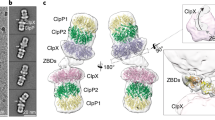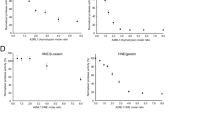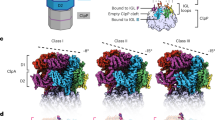Abstract
While the majority of proteins fold rapidly and spontaneously to their native states, the extracellular bacterial protease α-lytic protease (αLP) has a t 1/2 for folding of ~2,000 years, corresponding to a folding barrier of 30 kcal mol –1 . αLP is synthesized as a pro-enzyme where its pro region (Pro) acts as a foldase to stabilize the transition state for the folding reaction. Pro also functions as a potent folding catalyst when supplied as a separate polypeptide chain, accelerating the rate of αLP folding by a factor of 3 × 10 9 . In the absence of Pro, αLP folds only partially to a stable molten globule-like intermediate state. Addition of Pro to this intermediate leads to rapid formation of native αLP. Here we report the crystal structures of Pro and of the non-covalent inhibitory complex between Pro and native αLP. The C-shaped Pro surrounds the C-terminal ß-barrel domain of the folded protease, forming a large complementary interface. Regions of extensive hydration in the interface explain how Pro binds tightly to the native state, yet even more tightly to the folding transition state. Based on structural and functional data we propose that a specific structural element in αLP is largely responsible for the folding barrier and suggest how Pro can overcome this barrier.
This is a preview of subscription content, access via your institution
Access options
Subscribe to this journal
Receive 12 print issues and online access
$189.00 per year
only $15.75 per issue
Buy this article
- Purchase on Springer Link
- Instant access to full article PDF
Prices may be subject to local taxes which are calculated during checkout



Similar content being viewed by others
References
Zhu, X., Ohta, Y., Jordan, F. & Inouye, M. Nature 339, 483–484 (1989).
Baker, D., Silen, J.L. & Agard, D.A. Proteins Struct. Funct. Genet. 12, 339–344 (1992).
Strausberg, S., Alexander, P., Wang, L., Schwarz, F. & Bryan, P. Biochemistry 32, 8112– 8119 (1993).
Winther, J.R. & Sorensen, P. Proc. Natl. Acad. Sci. USA 88, 9330–9334 ( 1991).
Baker, D., Shiau, A.K. & Agard, D.A. Curr. Opin. Cell Biol. 5, 966 –970 (1993).
Sohl, J.L. & Agard, D.A., In Intramolecular Chaperones and Protein Folding (eds Shinde, U. & Inouye, M.) 61– 83 (R.G. Landes Co., Austin, Texas; 1995).
Silen, J.L. & Agard, D.A. Nature 341, 462–464 (1989).
Baker, D., Sohl, J.L. & Agard, D.A. Nature 356, 263– 265 (1992).
Peters, R.J. et al. Biochemistry, 37,12058– 12067 (1998).
Sohl, J.L., Jaswal, S.S. & Agard, D.A. Nature, in the press ( 1998).
Sohl, J.L., Shiau, A.K., Rader, S.D., Wilk, B.J. & Agard, D.A. Biochemistry 36, 3894– 3902 (1997).
Leahy, D.J., Hendrickson, W.A., Aukhil, I. & Erickson, H.P. Science 258, 987–991 ( 1992).
Bone, R., Shenvi, A.B., Kettner, C.A. & Agard, D.A. Biochemistry 26, 7609–7614 (1987).
Fersht, A. Enzyme structure and mechanism (W.H. Freeman, New York; 1985).
Gewirth, D.T. & Sigler, P.B. Nature Struct. Biol. 2, 386–394 (1995).
Schirmer, T. & Evans, P.R. Nature 343, 140–145 (1990).
Royer, W.E. Jr., Pardanani, A., Gibson, Q.H., Peterson, E.S. & Friedman, J.M. Proc. Natl. Acad. Sci. USA 93, 14526–14531 (1996).
Allaire, M., Chernaia, M.M., Malcolm, B.A. & James, M.N.G. Nature 369, 72–76 ( 1994).
Gallagher, T., Gilliland, G., Wang, L. & Bryan, P. Structure 3, 907–914 (1995).
Silen, J.L., McGrath, C.N., Smith, K.R. & Agard, D.A. Gene 69, 237–244 ( 1988).
LeMaster, D.M. & Richards, F.M. Biochemistry 24, 7263–7268 ( 1985).
Otwinowski, Z. & Minor, W. Methods Enzymol. 276, 307–326 ( 1997).
Hendrickson, W.A., Smith, J.L., Phizackerly, R.P. & Merritt, E.A. Proteins Struct. Funct. Genet. 4, 77– 88 (1988).
French, S. & Wilson, K. Acta Crystallogr. A 34 , 517–525 (1978).
de La Fortelle, E. & Bricogne, G. Meth. Enz. 276, 472–494 (1997).
Collaborative Computational Project, Number 4 Acta Crystallogr. D 50, 760–776 (1994).
Abrahams, J.P. & Leslie, A.W.G. Acta Crystallogr. D 52, 30–42 ( 1996).
Kleywegt, G.J. & Jones, T.A. Acta Crystallogr. D 53, 179–185 ( 1997).
Pannu, N.S. & Read, R.J. Acta Crystallogr. A 52 , 659–668 (1996).
Rice, L.M. & Brünger, A.T. Proteins Struct. Funct. Genet. 19, 277–290 ( 1994).
Brünger, A.T., Kuriyan, J. & Karplus, M. Science 235, 458– 460 (1987).
Brünger, A.T., Krukowski, A. & Erickson, J. Acta Crystallogr. A 46, 585– 593 (1990).
Brünger, A.T. X-PLOR version 3.1: a system for X-ray crystallography and NMR (Yale Univ. Press, New Haven, Connecticut; 1992).
Bone, R., Silen, J.L. & Agard, D.A. Nature 339, 191– 195 (1989).
Mau, I.-F.T. Ph. D. Thesis, University of California, San Francisco (1998).
Rader, S.D. Ph.D. Thesis, University of California, San Francisco (1996).
Read, R.J. Acta Crystallogr. A 42, 140–149 (1986).
Acknowledgements
This work was supported by the Howard Hughes Medical Institute (HHMI). N.K.S. was supported in part by a Damon Runyon-Walter Winchell postdoctoral fellowship, T.M. by an HHMI predoctoral fellowship, and S.D.R. by an NIH training grant. We thank D. King for mass spectroscopy analysis; C. Ogata (NSLS), M. Soltis and H. Bellamy (SSRL) for beamline support; P. David for logistical help; C. Wilson for the occasional use of his Raxis II; A. Shiau and A. Derman for assistance with data collection; and A. Derman, S. Gillmor, A. Shiau and J. Sohl for critical comments on the manuscript. Some data were collected at SSRL, which is operated by the Department of Energy, Office of Basic Energy Sciences. The SSRL Biotechnology Program is supported by the National Institutes of Health, National Center for Research Resources, Biomedical Technology Program, and by the Department of Energy, Office of Biological and Environmental Research.
Author information
Authors and Affiliations
Corresponding author
Rights and permissions
About this article
Cite this article
Sauter, N., Mau, T., Rader, S. et al. Structure of α-lytic protease complexed with its pro region. Nat Struct Mol Biol 5, 945–950 (1998). https://doi.org/10.1038/2919
Received:
Accepted:
Issue Date:
DOI: https://doi.org/10.1038/2919
This article is cited by
-
Structural Studies of Component of Lysoamidase Bacteriolytic Complex from Lysobacter sp. XL1
The Protein Journal (2016)
-
Characterization of an extensin-modifying metalloprotease: N-terminal processing and substrate cleavage pattern of Pectobacterium carotovorum Prt1
Applied Microbiology and Biotechnology (2014)
-
Evolution of the Genetic Code by Incorporation of Amino Acids that Improved or Changed Protein Function
Journal of Molecular Evolution (2013)
-
The Mad2 spindle checkpoint protein has two distinct natively folded states
Nature Structural & Molecular Biology (2004)
-
Metastable states and folding free energy barriers
Nature Structural Biology (1998)




